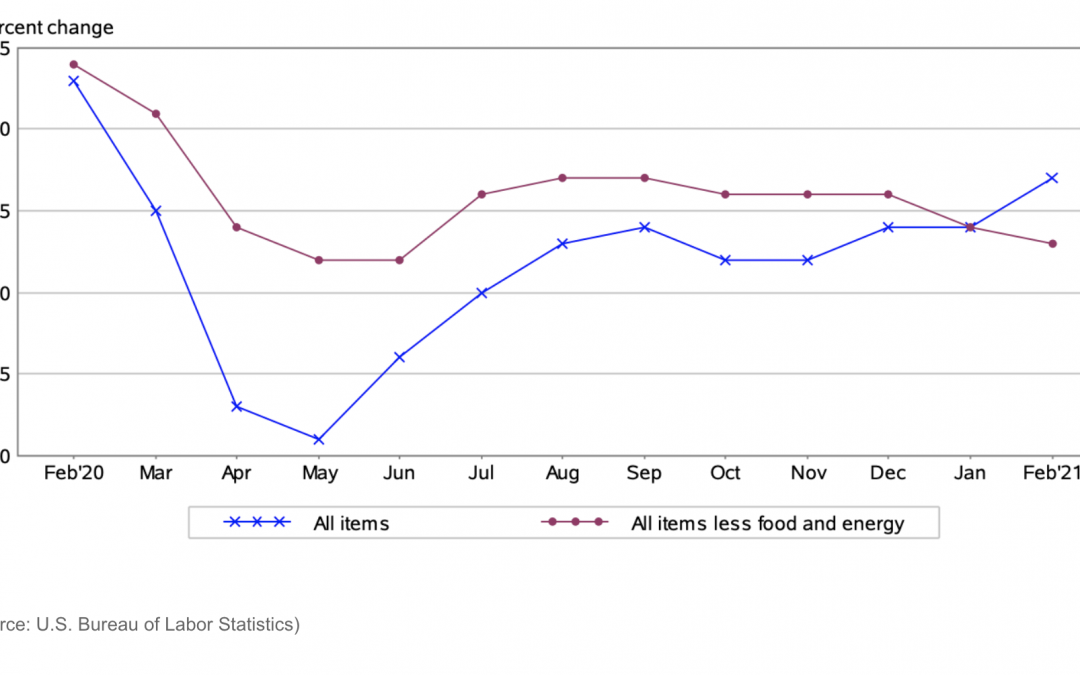
by Sarah Bauder | Mar 10, 2021 | CPI
The Consumer Price Index for All Urban Consumers (CPI-U) edged up 0.4% in February, reported the U.S. Bureau of Labor Statistics. Before seasonal adjustment, the all items index rose 1.7% since this time last year.
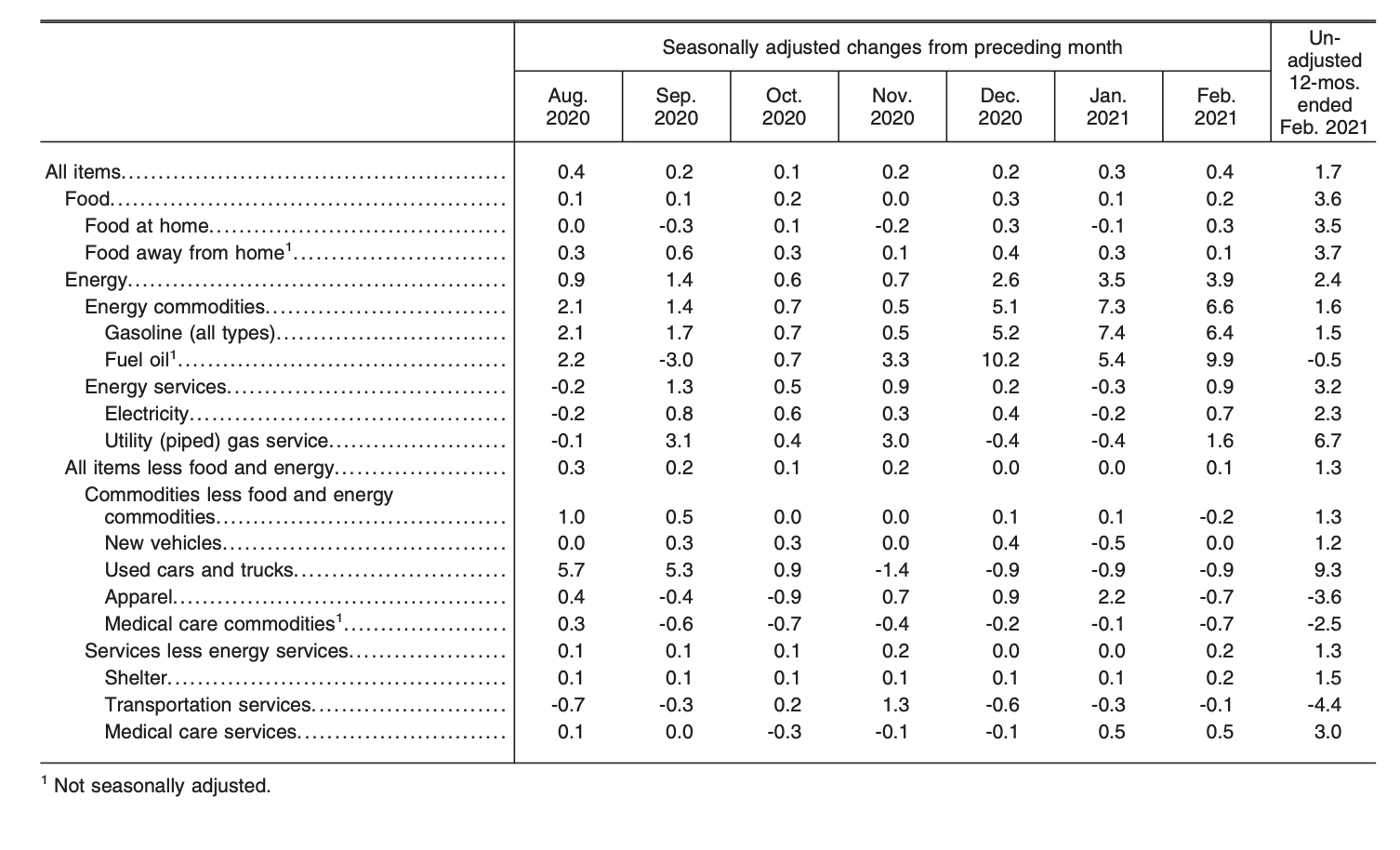
(Source: U.S. Bureau of Labor Statistics)
Energy Index
The index for energy increased 3.9% in February, continuing its upward trajectory. The price of gasoline was a primary component for the rise with a 6.4% increase reported the bureau. The indexes for electricity, natural gas, and fuel oil all rose, 0.7%, 1.6%, and 9.9%, respectively.
Over the last 12-month period, the energy index increased 2.4%. Gasoline prices increased 1.5%, as did the electricity index by 2.3%, and the natural gas index by 6.7%. Conversely, over the last 12-month span, the index for fuel oil dropped 0.5%.
Food Index
In February, the index for food rose 0.2%. The food at home index rose 0.3%, as did the index for food away from home by 0.1%.
“The food at home index increased 3.5% over the past 12 months. All six major grocery store food group indexes increased over the period, with increases ranging from 2.7% (both cereals and bakery products and dairy and related products) to 5.2% (meats, poultry, fish, and eggs). The index for food away from home rose 3.7% over the last year. The index for limited service meals rose 6.3% , the largest 12-month increase in the history of the index, which began in 1997. The index for full service meals rose 2.9% over the last 12 months,” the U.S. Bureau of Labor Statistics explained in its report.
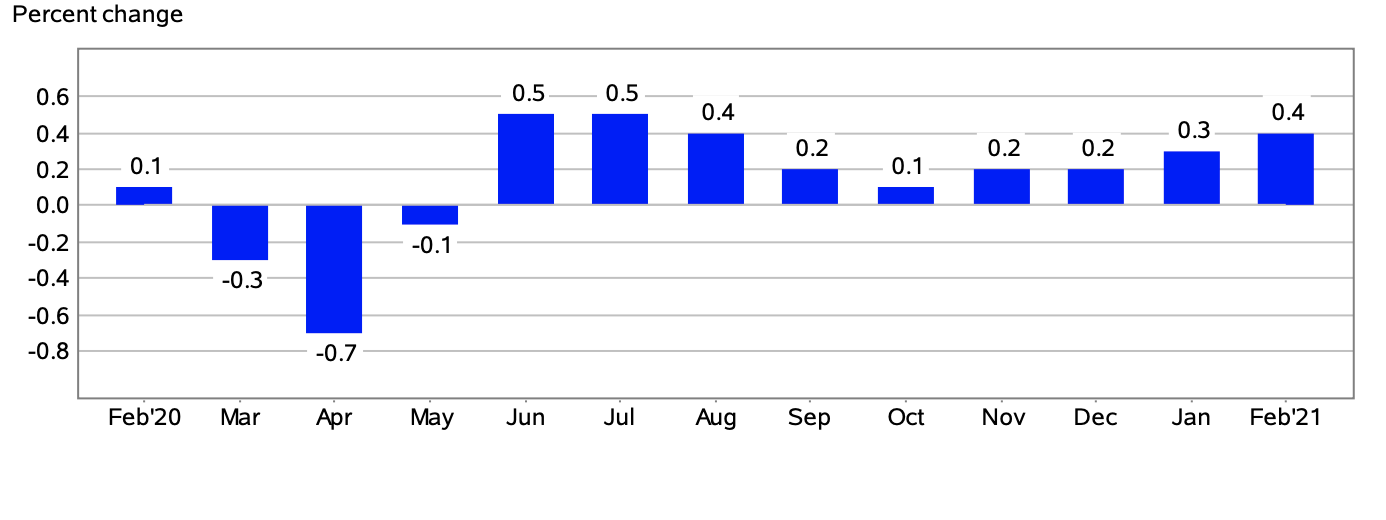
(Source: U.S. Bureau of Labor Statistics)
All Items Less Food and Energy
The all items less food and energy index edged up 0.1% for the month, reported the bureau. Several component indexes saw percentage increases including the shelter index by 0.2%, the owners’ equivalent rent index by 0.3%, and the rent index by 0.2%.
Over the last 12-month period the all items less food and energy index increased 1.3%.
“Among the indexes rising more quickly were those for used cars and trucks (+9.3%), medical care (+2.0%), and shelter (+1.5%),” stated the bureau.
By contrast, indexes that decreased over the last 12-month period include the indexes for airline fares by 25.6%, apparel by 3.6%, and motor vehicle insurance by 2.8%.
The US Bureau of Labor Statistics released a statement regarding the impact of the COVID-19 pandemic for the February 2021 data collection:
“Data collection by personal visit for the Consumer Price Index (CPI) program has been suspended since March 16, 2020. When possible, data normally collected by personal visit were collected either online or by phone. Additionally, data collection in February was affected by the temporary closing or limited operations of certain types of establishments. These factors resulted in an increase in the number of prices considered temporarily unavailable and imputed. While the CPI program attempted to collect as much data as possible, many indexes are based on smaller amounts of collected prices than usual, and a small number of indexes that are normally published were not published this month.”
Source cited: https://www.bls.gov/news.release/archives/cpi_03102021.htm
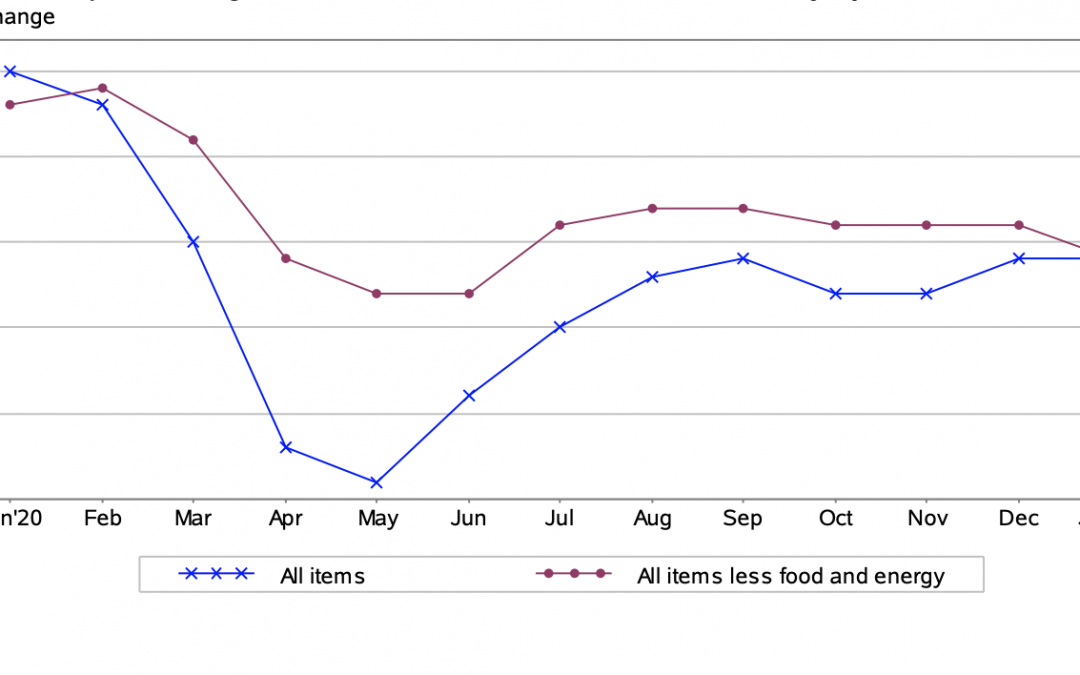
by Sarah Bauder | Feb 10, 2021 | CPI
The Consumer Price Index for All Urban Consumers (CPI-U) rose 0.3% in January, reported the U.S. Bureau of Labor Statistics. Before seasonal adjustment, the all items index increased 1.4% since this time last year.
Energy Index
In January, the index for energy rose 3.5%. The price of gasoline was the main contributor to the overall increase, with a percentage increase of 7.4%. In addition, the index for fuel oil also increased for the month by 5.4%.
Conversely, both the index for electricity and index for natural gas dropped in January, 0.2% and 0.4%, respectively.
“The energy index fell 3.6% over the past 12 months. Despite recent monthly increases, the gasoline index fell 8.6% over the last 12 months, and the fuel oil index fell 16.5%. The index for electricity, however, rose 1.5% over the last 12 months and the index for natural gas increased 4.3%,” stated U.S. Bureau of Labor Statistics.

(Source: U.S. Bureau of Labor Statistics)
Food Index
The index for food rose 0.1% in the month of January. The food at home index declined 0.1% as there were drops in four out six component grocery store food indexes. The index for food away from home increased 0.3%.
Over the last 12-month period, the food at home index has risen 3.7%. Moreover, the food away from home index also increased 3.9% since this time last year.
All Items Less Food and Energy
In January, the all items less food and energy index remained unchanged, reported the U.S. Bureau of Labor Statistics. Several component indexes saw percentage increases in January including the shelter index at 0.1%, the apparel index at 2.2%, and the medical care index by 0.4%.
Conversely, component indexes that decreased for the month included the index for airline fares by 3.2%, the used cars and trucks index by 0.9%, and the index for new vehicles by 0.5%.
Over the last year, the all items less food and energy index increased 1.4%.
The US Bureau of Labor Statistics released a statement on the impact of the COVID-19 pandemic on January 2021 Consumer Price Index data:
“Data collection by personal visit for the Consumer Price Index (CPI) program has been suspended since March 16, 2020. When possible, data normally collected by personal visit were collected either online or by phone. Additionally, data collection in January was affected by the temporary closing or limited operations of certain types of establishments. These factors resulted in an increase in the number of prices considered temporarily unavailable and imputed. While the CPI program attempted to collect as much data as possible, many indexes are based on smaller amounts of collected prices than usual, and a small number of indexes that are normally published were not published this month. Additional information is available at www.bls.gov/covid19/effects-of-covid-19-pandemic-on-consumer-price-index.htm.”
Source cited: https://www.bls.gov/news.release/archives/cpi_02102021.htm
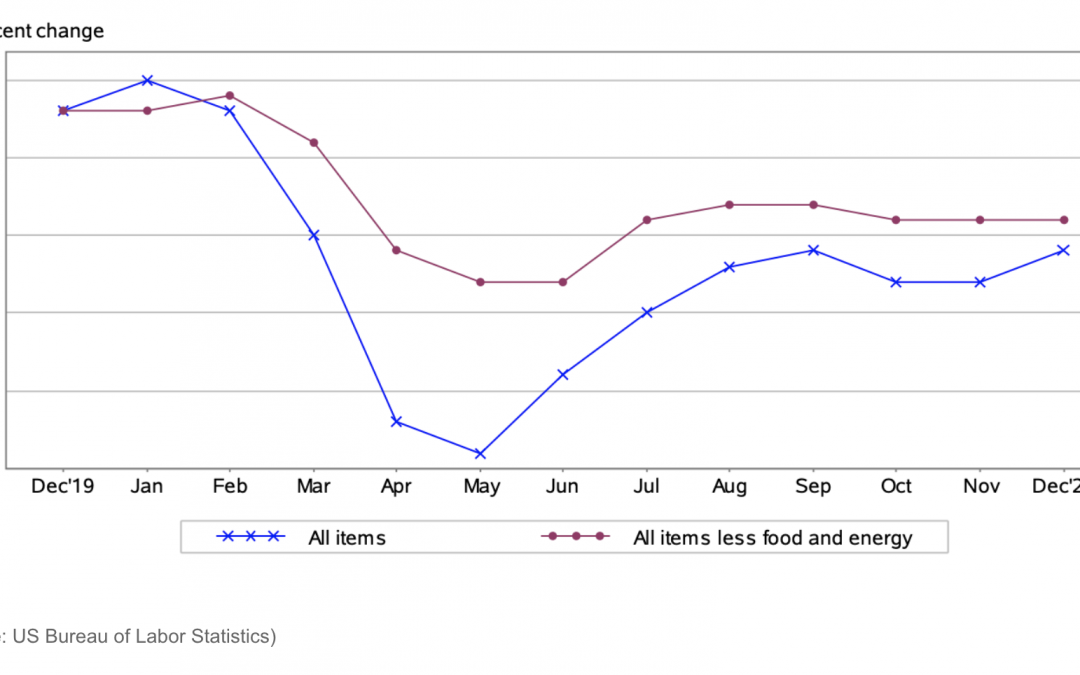
by Sarah Bauder | Jan 13, 2021 | CPI
The Consumer Price Index for All Urban Consumers (CPI-U) edged up 0.4% in December on a seasonally adjusted basis, reported the US Bureau of Labor Statistics. This is a slight increase from the 0.2% rise seen in November.
Before seasonal adjustment, the all items index rose by 1.4%, over the past 12 month period.

(Source: US Bureau of Labor Statistics)
Energy Index
In December, the energy index increased by 4%, marking the seventh consecutive monthly percentage rise.
“The largest contribution to this increase was the gasoline index, which increased 8.4% in December after declining in the previous two months. Before seasonal adjustment, gasoline prices rose 3.4% in December,” reported the Bureau of Labor Statistics.
The electricity index also increased by 0.4%, while the natural gas index declined 0.8% for the month of December.
Over the last year, the index for energy decreased by 7%. The fuel oil index plummeted 20%, and likewise, gas prices plunged 15.2%. Conversely, the natural gas index rose 4.1%, and the index for electricity edged up 2.2% over the same 12-month period.
Food Index
The index for food rose 0.4% in December. The food at home index edged up 0.4%, as did the index for food away from home by 0.4%, while the major grocery store indexes were mixed.
Over the last 12-month period, the food at home index and the food away from home index both rose 3.9%. Additionally, all of the six major grocery store indexes saw percentage increases.
“The largest increase was the meats, poultry, fish, and eggs index which rose 4.6% as the beef index increased 5.3%. The smallest increases were for the cereals and bakery products and the fruits and vegetables indexes, which both increased 3.2% over the last 12 months,” explained the Bureau of Labor Statistics.
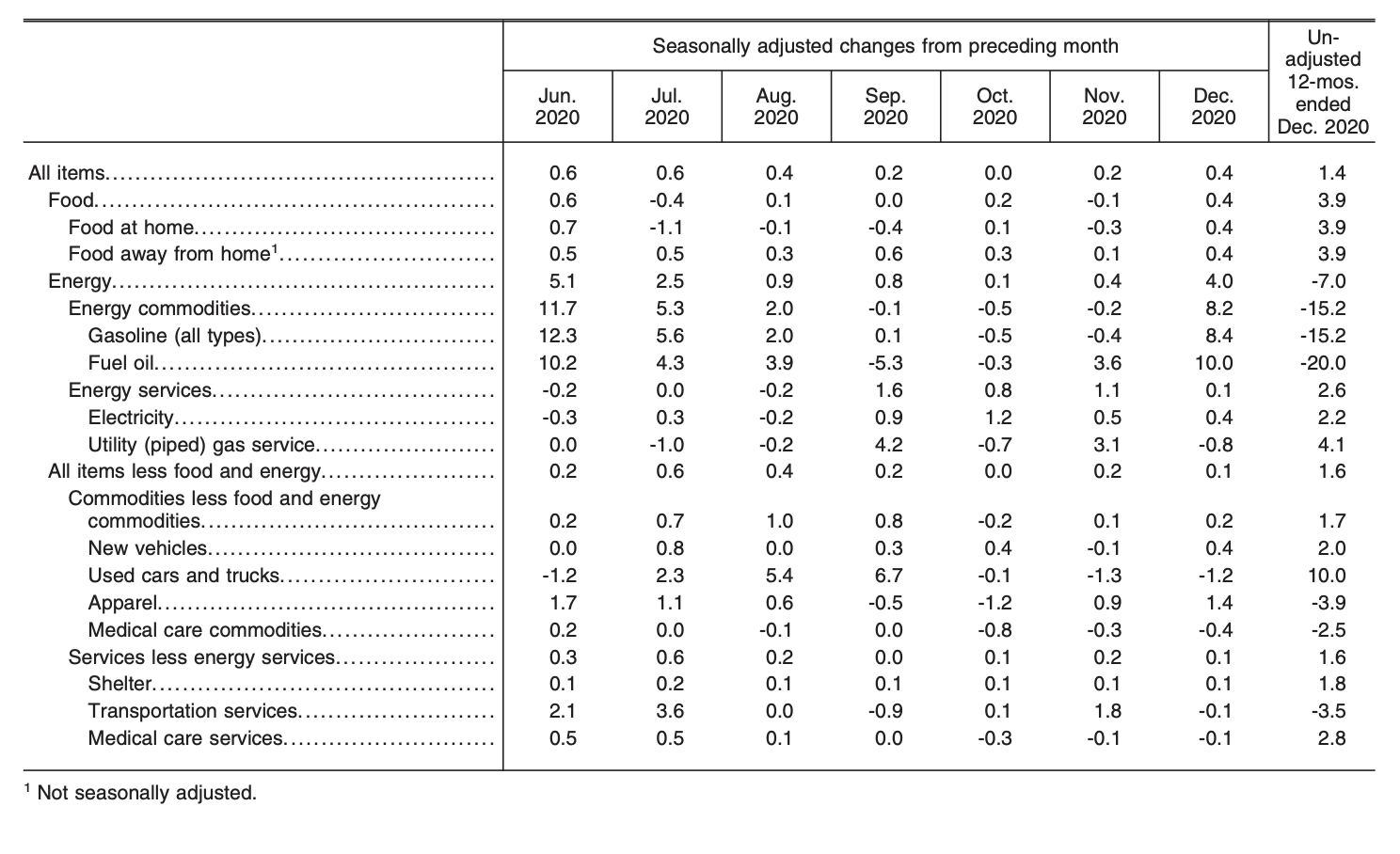
(Source: US Bureau of Labor Statistics)
All Items Less Food and Energy
In December, the index for all items less food and energy increased by 0.1%. Several of the component indexes all saw slight percentage increases for the month including the shelter index by 0.1%, and both the rent index and index for owners’ equivalent rent rose 0.1%.
Over the last 12 months, the all items less food and energy index increased 1.6%. The index for shelter edged up 1.8%. Component indexes that saw major percentage decreases were airline fares, apparel, motor vehicle insurance reported the US Bureau of Labor Statistics.
Source cited: https://www.bls.gov/news.release/archives/cpi_01132021.htm

by Sarah Bauder | Dec 10, 2020 | CPI, Definitions
The Consumer Price Index for All Urban Consumers (CPI-U) edged up 0.2% in November, reported the U.S. Bureau of Labor Statistics. Before seasonal adjustment, the all items index increased 1.2% since this time last year.
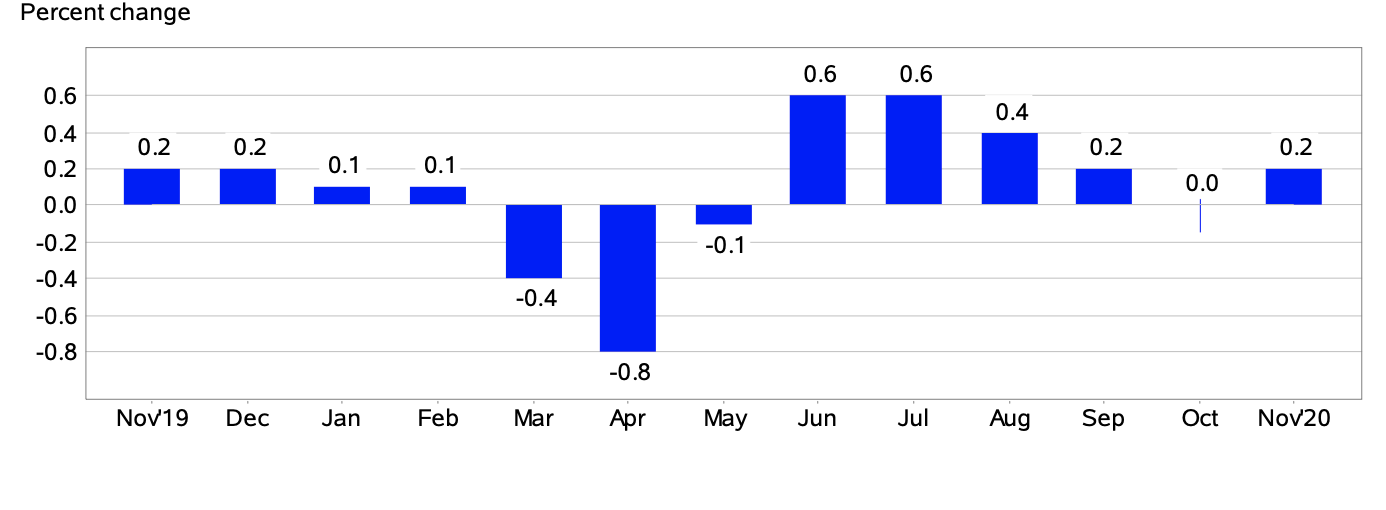
(Source: U.S. Bureau of Labor Statistics)
Food Index
The index for food dropped 0.1% in November, after rising 0.2% the previous month. The food at home index decreased 0.3%.
“Major grocery store food group indexes were mixed in November. The index for nonalcoholic beverages fell 0.9 percent in November, its largest monthly decline since December 2010. The index for other food at home fell 0.6 percent in November, and the index for cereals and bakery products decreased 0.5 percent; both indexes increased in October,” reported the U.S. Bureau of Labor Statistics.
Over the past 12 month period, the food at home index rose 3.6%. All six major grocery store group indexes saw percentage increases since this time last year. The index for meats, poultry, fish, and eggs saw the largest percentage rise at 5.9%, with specifically the index for beef edging up 7.5% over the last 12 months. Likewise, the food away from home index increased by 3.8% over the same timeframe.
Energy Index
The index for energy increased 0.4% in November, marking the sixth consecutive monthly percentage rise. The indexes for natural gas, electricity, and fuel oil all rose, 3.1%, 0.5%, 3.6%, respectively.
“In contrast to these increases, the gasoline index declined for the second month in a row, falling 0.4%. Before seasonal adjustment, gasoline prices fell 2.7% in November,” stated the bureau in its report.
Over the last 12-month period, the energy index dropped 9.4%. The price of gasoline plunged 19.4%, and the index for fuel oil plummeted an astonishing 26.4% since this time last year. Conversely, the natural gas and electricity indexes rose 4.4% and 1.6%, respectively.
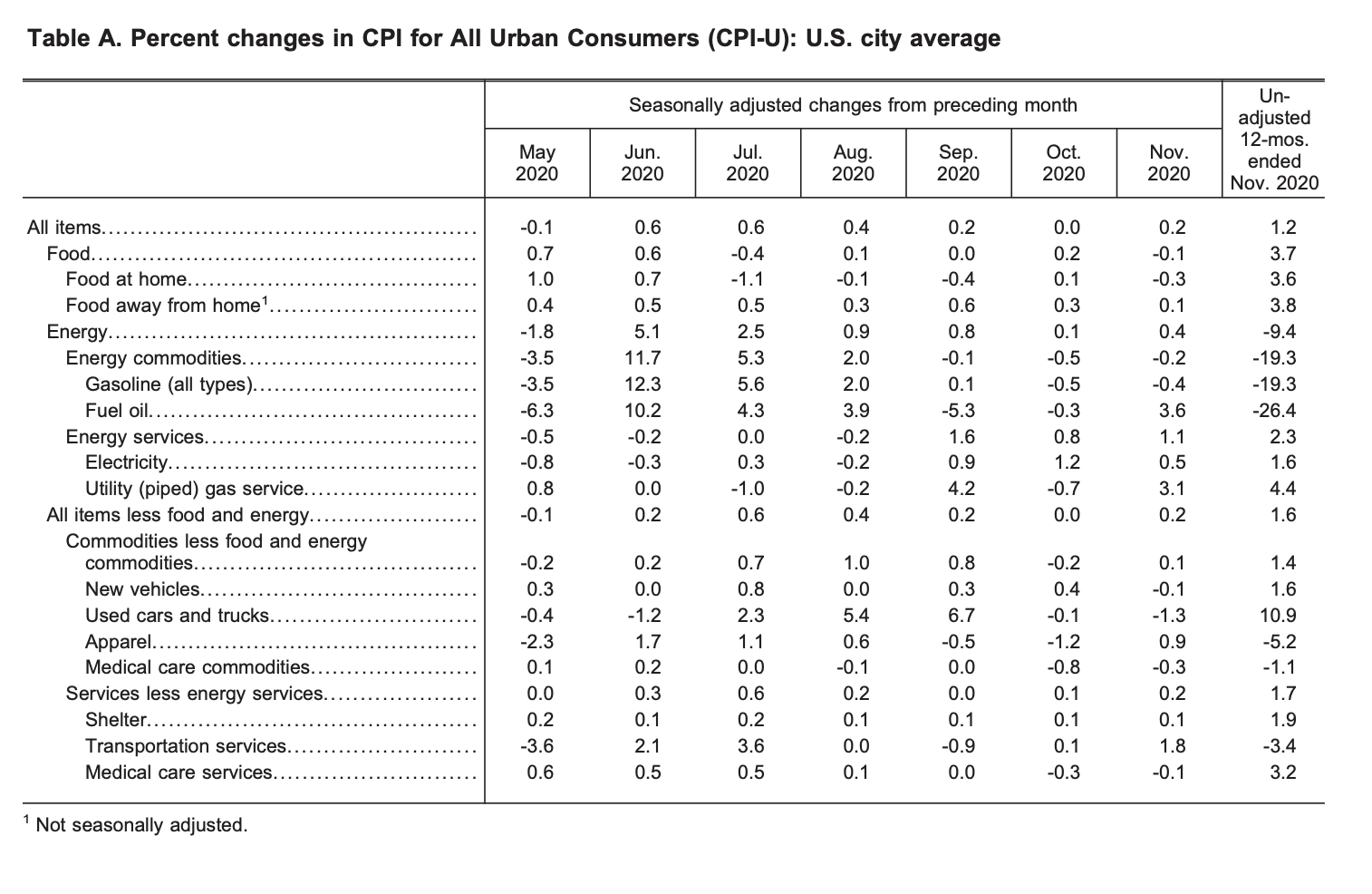
(Source: U.S. Bureau of Labor Statistics)
All Items Less Food and Energy
In November, the all items less food and energy index edged up 0.2%, reported the U.S. Bureau of Labor Statistics. Several component indexes saw percentage increases including the shelter index at 0.1%, the apparel index at 0.9%, airline fares at 3.5%, and motor vehicle insurance at 1.1%.
Over the last year, the all items less food and energy index increased by 1.6%. The index for shelter edged up 1.9% over the past 12-month span, as did the medical care index with a percentage increase of 2.4%.
“Despite the monthly increases in November, the indexes for apparel, airline fares, and motor vehicle insurance all declined over the past 12 months,” reported the U.S. Bureau of Labor Statistics.
The US Bureau of Labor Statistics released a statement on the impact of the COVID-19 pandemic for the November 2020 data collection:
“Data collection by personal visit for the Consumer Price Index (CPI) program has been suspended since March 16, 2020. When possible, data normally collected by personal visit were collected either online or by phone. Additionally, data collection in November was affected by the temporary closing or limited operations of certain types of establishments. These factors resulted in an increase in the number of prices considered temporarily unavailable and imputed. While the CPI program attempted to collect as much data as possible, many indexes are based on smaller amounts of collected prices than usual, and a small number of indexes that are normally published were not published this month. Additional information is available at www.bls.gov/covid19/effects-of-covid-19-pandemic-on-consumer-price-index.htm.”
Source cited: https://www.bls.gov/news.release/archives/cpi_12102020.htm
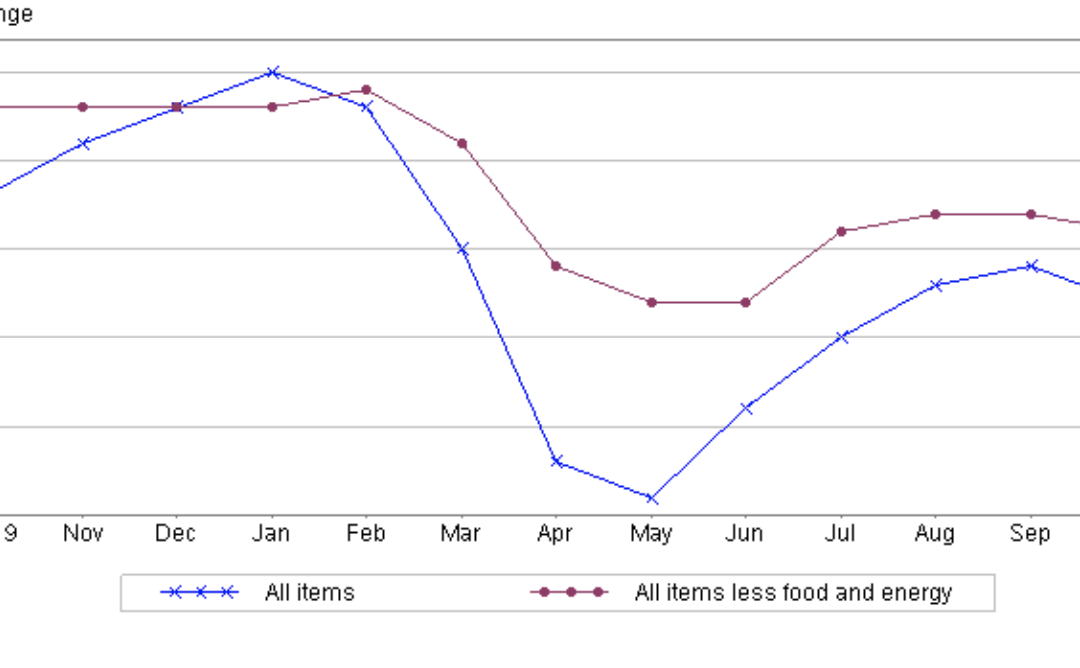
by Sarah Bauder | Nov 12, 2020 | CPI
The US Bureau of Labor Statistics reported that the Consumer Price Index for All Urban Consumers (CPI-U) in October remained the same on a seasonally adjusted basis. In September, the CPI had edged up 0.2%.
Before seasonal adjustment, the all items index increased by 1.2% over the past 12 month period.
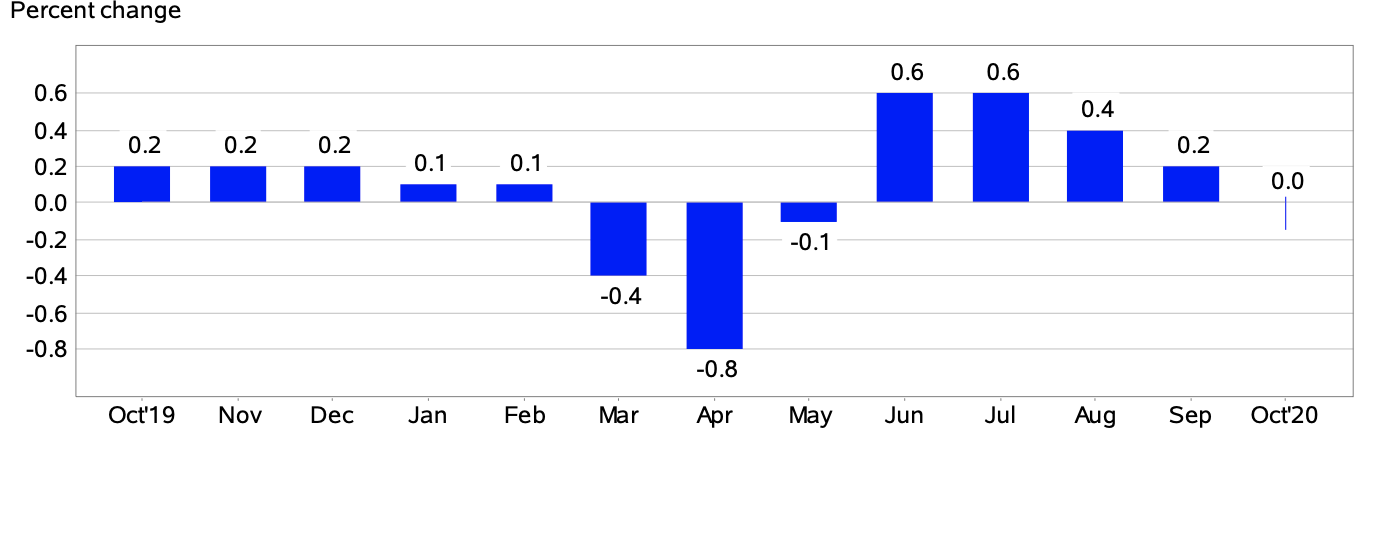
(Source: US Bureau of Labor Statistics)
Food Index
The index for food increased 0.2% after remained the same for the month of September. The food at home index rose 0.1%, with four of the six major grocery store group indexes seeing percentage increases.
“The index for meat, poultry, fish, and eggs increased 0.4 percent in October following a 0.4-percent decrease in September. The indexes for other food at home and for cereals and bakery products both rose 0.3 percent in October, while the index for fruits and vegetables increased 0.1 percent,” explained the bureau.
Over the past 12 month span, the index for food at home index increased 4%. All six major grocery store group indexes saw percentage increases since this time last year. Moreover, the food away from home index increased by 3.9% over the last 12 months – “the largest 12-month increase reported for that index since May 2009”, explained the US Bureau of Labor Statistics.
Energy Index
In October, the index for energy increased 0.1%, marking the fifth consecutive monthly percentage rise. “The electricity index was the largest contributor to this increase, increasing 1.2%,” stated the bureau. Gas prices dropped 0.5%, as did the natural gas index by 0.7%.
Over the last 12-months, the index for energy decreased 9.2%. The price of gasoline declined 18%, and the fuel oil index plummeted 28.2%. “In contrast, energy service indexes rose, with the index for natural gas increasing 1.8% and the index for electricity advancing 1.3%,” reported the bureau.

(Source: US Bureau of Labor Statistics)
All Items Less Food And Energy
In October, the all items less food and energy index remained the same, after rising 0.2% the previous month, stated US Bureau of Labor Statistics. Several of the component indexes all saw slight percentage increases for the month including the shelter index by 0.1%, and both the rent index and index for owners’ equivalent rent by 0.2%.
Over the last year, the all items less food and energy index increased by 1.6%. The index for shelter edged up 2%, as did the medical care index by 2.9%. Conversely, component indexes that saw percentage decreases were motor vehicle insurance, airline fares, and apparel stated the US Bureau of Labor Statistics.
The US Bureau of Labor Statistics released a statement on the impact of the COVID-19 pandemic on data collection:
“Data collection by personal visit for the Consumer Price Index (CPI) program has been suspended since March 16, 2020. When possible, data normally collected by personal visit were collected either online or by phone. Additionally, data collection in October was affected by the temporary closing or limited operations of certain types of establishments. These factors resulted in an increase in the number of prices considered temporarily unavailable and imputed. While the CPI program attempted to collect as much data as possible, many indexes are based on smaller amounts of collected prices than usual, and a small number of indexes that are normally published were not published this month. Additional information is available here.”
Source cited: https://www.bls.gov/news.release/archives/cpi_11122020.htm
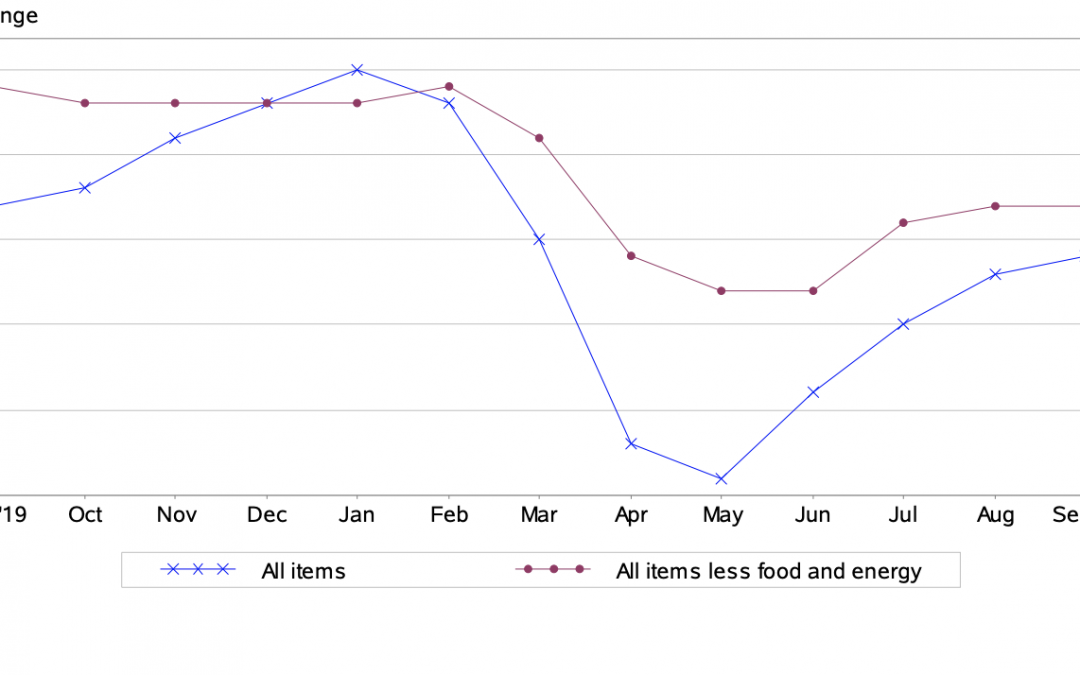
by Sarah Bauder | Oct 13, 2020 | CPI
The Consumer Price Index for All Urban Consumers (CPI-U) rose 0.2% on a seasonally adjusted basis, reported the US Bureau of Labor Statistics.
Before seasonal adjustment, the all items index increased by 1.3%, over the past 12 month period.

(Source: US Bureau of Labor Statistics)
Food Index
Surprisingly, the index for food remained the same for the month of September, reported the bureau. The food at home index dropped 0.4%, with five of the six major grocery store group indexes seeing percentage decreases. “The index for meats, poultry, fish, and eggs fell 0.4% in September, its third consecutive monthly decline,” explained the bureau. Conversely, the food away from home index rose 0.6%.
Over the past 12 month span, the index for food at home edged up 4.6%. All six major grocery store group indexes saw percentage increases since this time last year. Additionally, the food away from home index increased by 3.8% over the last 12 months.
Energy Index
In September, the index for energy increased by 0.8%, marking the fourth consecutive monthly percentage rise. “ However, unlike previous months, the index for natural gas was the largest contributor to the monthly increase, rising 4.2 percent, its largest monthly increase since December 2018,” reported the US Bureau of Labor Statistics. In addition, the index for electricity increased by 0.9%, which also marked its largest rise in two years.
Over the last 12-months, the index for energy decreased by 7.7%. Gas prices dropped 15.4%, and the fuel oil index plunged 27.2%. “In contrast, energy service indexes rose, with the index for natural gas increasing 3.8% and the index for electricity advancing 0.7%,” exp[lained the bureau.
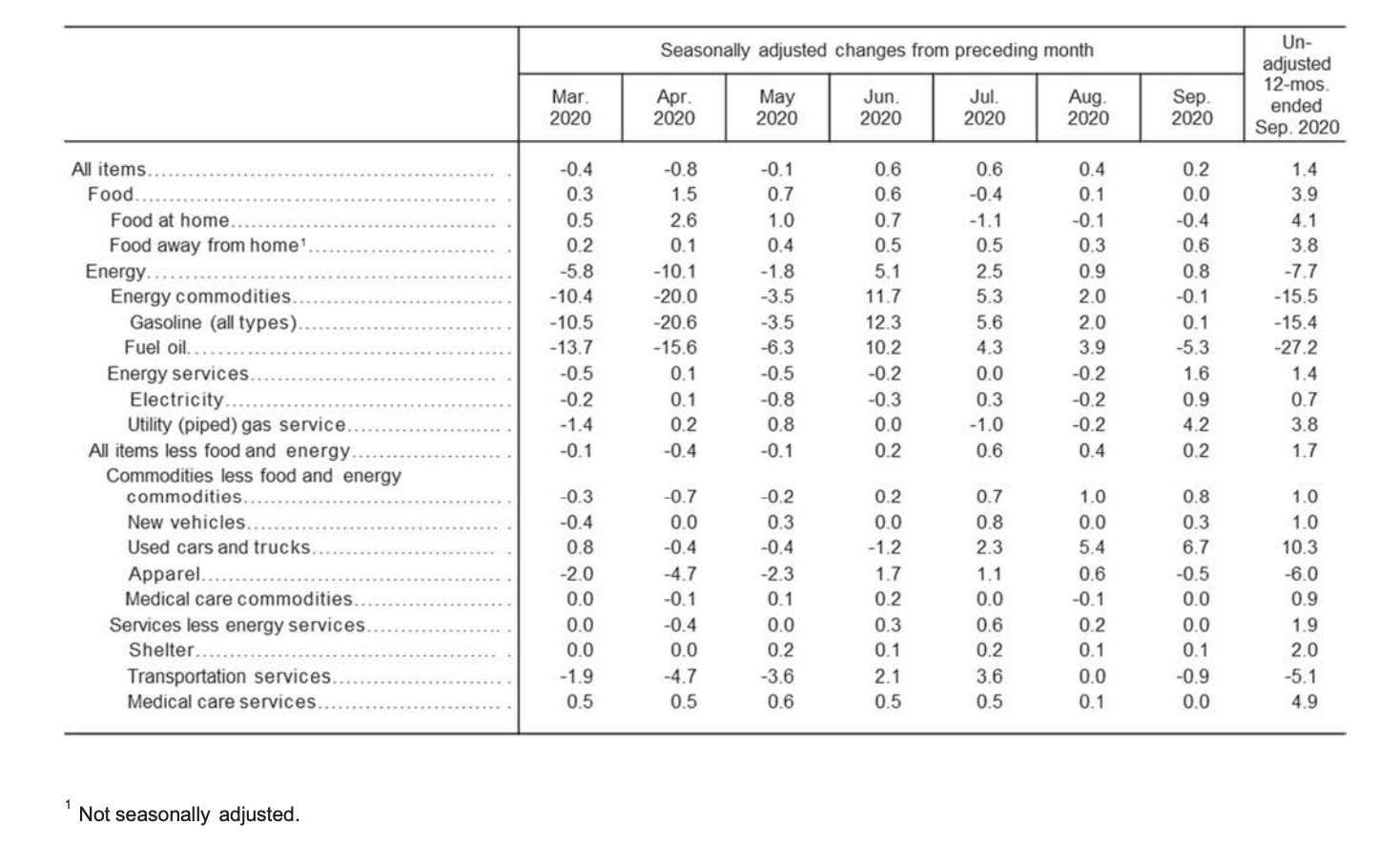
(Source: US Bureau of Labor Statistics)
All Items Less Food And Energy Index
In September, the all items less food and energy index rose 0.2%. Akin to in August, this was primarily due to the used cars and trucks index, which increased 6.7%. “The used cars and trucks index accounted for more than 100% of the monthly increase in the index for all items less food and energy,” stated the bureau in its report. Several of the component indexes all saw slight percentage increases for the month including the shelter index by 0.1%, and both the rent index and index for owners’ equivalent rent by 0.1%.
Over the last year, the all items less food and energy index increased by 1.7%. The index for shelter edged up 2%, as did the medical care index by 4.2%. Component indexes that saw percentage decreases were motor vehicle insurance, airline fares, and apparel stated the bureau.
Source cited: https://www.bls.gov/news.release/archives/cpi_10132020.htm



















